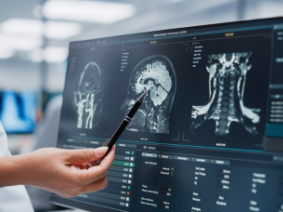Spinal Fusion
Spinal fusion refers to the procedure that joins two or more bones in your spine so they can no longer move independently. These bones, called vertebrae, are permanently connected using bone grafts, implants or both. Over time, the bones grow together and heal as a single unit.
This technique is often used to stabilize the spine, correct deformities or relieve pain caused by movement between vertebrae. If you have ever asked yourself what spinal fusion is, think of it as a way to restore stability and reduce irritation caused by abnormal motion in the spine.
When Is Spinal Fusion Necessary?
Spinal fusion surgery is typically recommended when other treatments have not relieved pain or when the spine shows signs of significant damage. You may be a candidate if you are dealing with:
- Degenerative disc disease, where the cushioning between vertebrae breaks down
- Scoliosis, which causes the spine to curve abnormally
- Spinal instability, often due to fractures, tumors or arthritis
- Spondylolisthesis, when one vertebra slips forward over another
- Herniated or damaged discs requiring additional support after removal
Knowing when spinal fusion is necessary depends on a detailed medical evaluation. At Neurosurgical Associates of Central Jersey, our surgeons carefully review your symptoms, imaging results and response to prior treatments before recommending any surgical step. If we can relieve your symptoms through less invasive means, we always explore those first.
How Does Spinal Fusion Surgery Work?
During spinal fusion surgery, you are placed under general anesthesia so you sleep through the procedure. The surgical team then accesses the problem area in your spine, either from the front, back or side, depending on what part needs treatment. After preparing the area, the surgeon places a bone graft or implant between the vertebrae. Sometimes screws, rods or plates are added to hold the bones in place as they heal.
The bone graft may come from your own body, a donor or a synthetic material. As you heal, new bone tissue forms and eventually fuses the vertebrae together. The technique used is based on your specific spinal condition and what approach offers the most benefit with the least disruption.
What Is Recovery From Spinal Fusion Like?
Spinal fusion recovery takes time, but most patients gradually return to normal activity. Hospital stays typically last 2 to 4 days. Once home, you may need to limit bending, twisting or lifting for several weeks. Physical therapy often begins a few weeks after surgery to help you regain strength and improve mobility.
The full healing process may take several months. During that time, you will have follow-up visits to check on your progress.
At Neurosurgical Associates of Central Jersey, our team is involved throughout your entire spinal fusion recovery, from post-operative guidance to long-term spine health.
Common Problems After Spinal Fusion
Like any surgery, there are risks. Some common problems after spinal fusion include infection, bleeding or nerve irritation. In some cases, the vertebrae may not fuse completely, requiring additional procedures. Another consideration is adjacent segment disease, where the parts of the spine above or below the fused area begin to wear more quickly due to increased stress.
These risks are not meant to alarm but to inform. The goal is to help you make decisions with full awareness.
At Neurosurgical Associates of Central Jersey, we use advanced techniques and personalized care plans to reduce complications and support the best possible outcome.
Talk to a Spine Specialist Today
If you are considering spinal fusion or looking for answers about chronic spine pain, we are here to help. At Neurosurgical Associates of Central Jersey, we take time to evaluate your condition, explain your options and guide you toward lasting relief.
Contact us today to schedule a consultation and explore what your path to recovery could look like.



